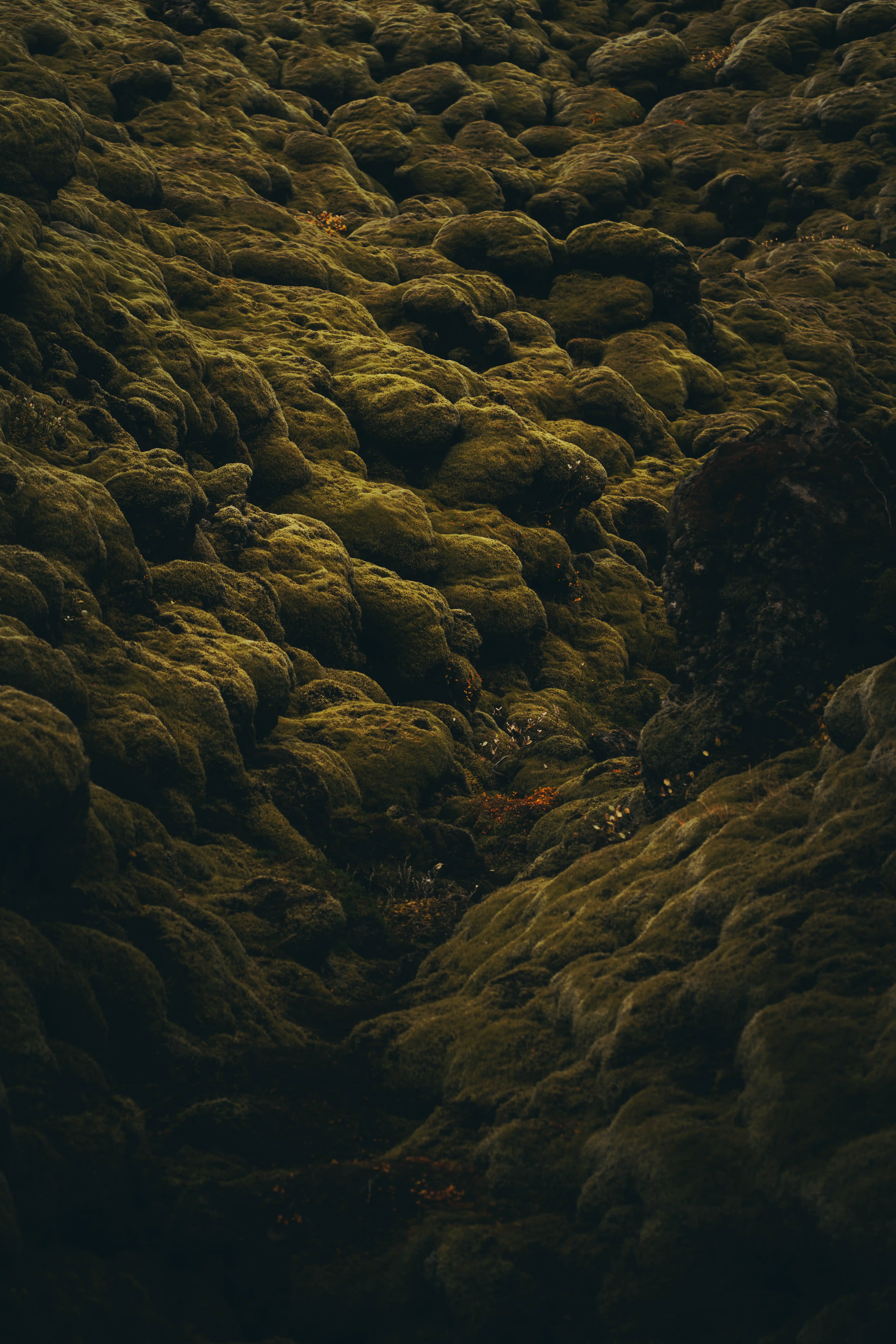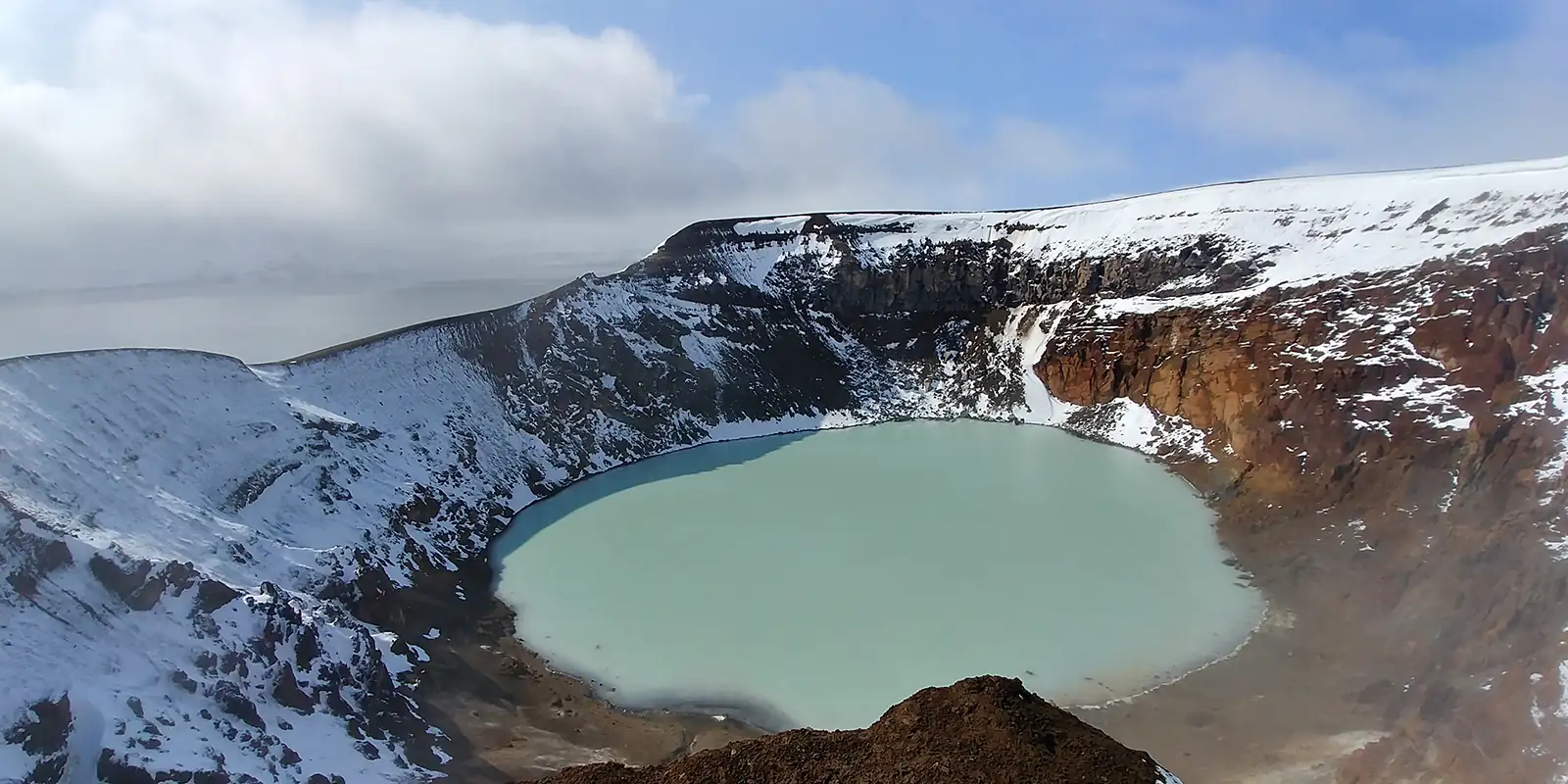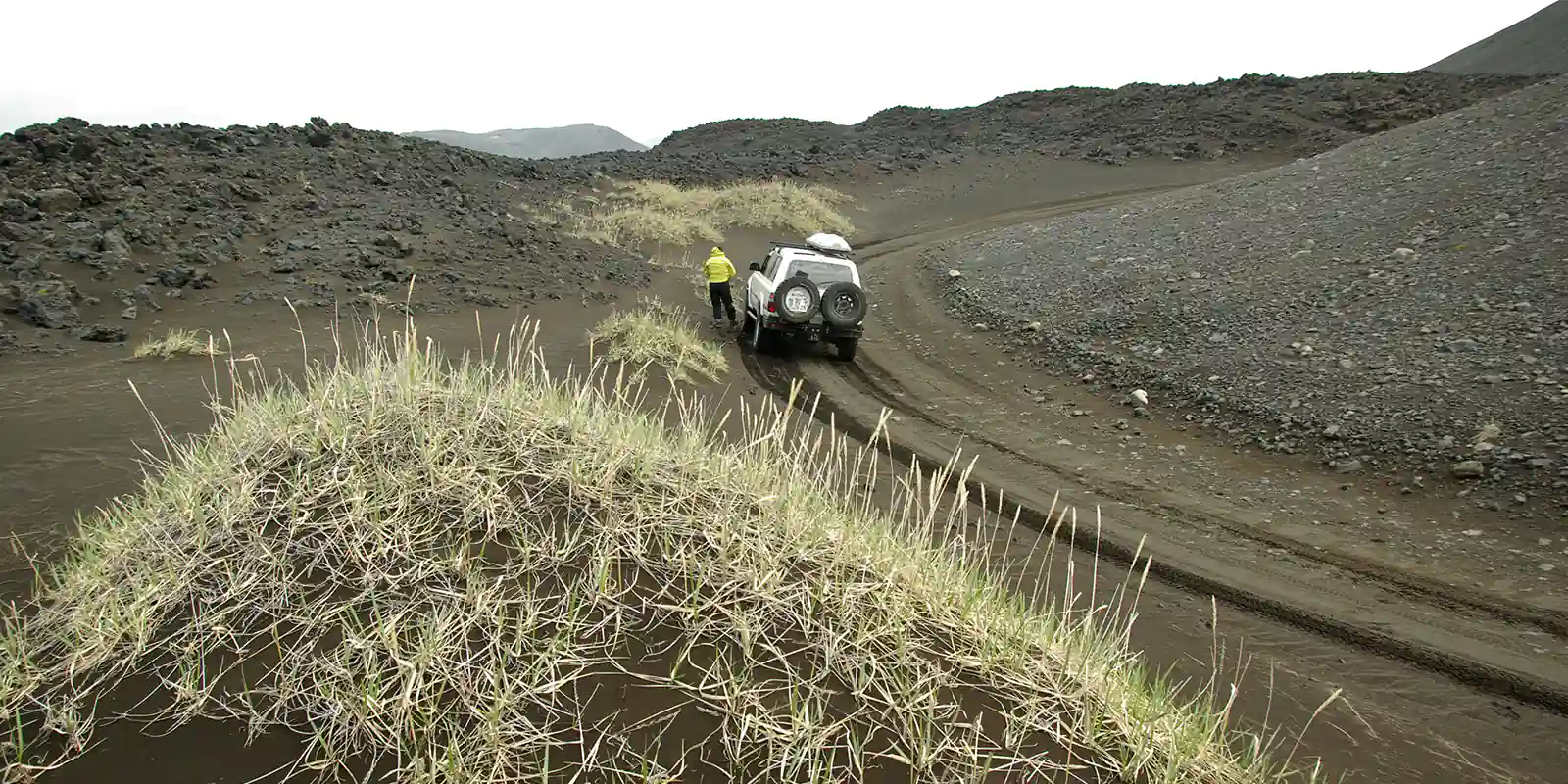Viti crater is a stunning turquoise-colored lake that formed within the Askja volcano caldera. The crater is approximately 300 meters wide and 60 meters deep, and its vivid color is due to the high concentration of minerals in the water. Visitors can hike down to the edge of the crater for a closer look or take in the view from above. The crater's serene beauty is in contrast to the volcano's violent past and serves as a reminder of the incredible natural forces that shape our world.

Uncovering the Secrets of Askja Volcano in Iceland
Exploring Askja : An Adventure in Iceland's Heartland
As visitors make their way to Askja, they open the door to a world of captivating exploration. Here, you can choose your own path or opt for a guided journey—either way, the rewards are boundless. The hike to the caldera is an inviting challenge, not overly strenuous but certainly a test of stamina as you ascend a gravel path. Your efforts are met with a visual masterpiece, an awe-inspiring view of the crater lake, set like a sapphire jewel amidst the rugged landscape.
Lava field created by a volcanic eruption in 2014
Heated by the Earth's geothermal pulse, it's a popular spot for those who dare to take a refreshing dip. Nearby, Holuhraun unfolds—a vast lava field created by a volcanic eruption in 2014. Though it has been years, it remains a testament to the raw power of nature and a mesmerizing sight.
Journey to Askja: A Land of Fire and Ice
Askja Volcano : Exploring Iceland's Hidden Gem in the Highlands
When travelers conjure images of Iceland, they often envision sprawling glaciers, bubbling hot springs, and cascading waterfalls. Yet, Iceland's untamed beauty stretches beyond these iconic scenes, into the remote and rugged Icelandic Highlands, where a geological masterpiece lies concealed: Askja volcano.
Nestled at the very heart of Iceland, Askja is a prized gem within the Vatnajökull National Park. This region is renowned for its otherworldly landscape adorned with jet-black sand plains, vast lava fields, and the ever-present, steaming geothermal pools.
However, what truly distinguishes Askja is its surreal caldera—a colossal crater, home to Iceland's deepest and most mesmerizing crater lake, cloaked in a breathtaking shade of blue. Rimmed by dramatic, sheer cliffs, this caldera lake ranks among the top attractions for travelers exploring the Icelandic Highlands.
A Closer Look at Askja's Geological Marvels
The Askja volcano presents a unique blend of stark beauty and geological significance. Enthusiasts in geology and nature's wonders are drawn to this location like moths to a flame. The striking contrasts found here serve as a remarkable testament to Earth's geological diversity.A noteworthy feature is Askja's central caldera, an ancient feature formed through the eruption of Mount Askja, which took place nearly two centuries ago. This violent outburst resulted in massive lava flows that stretched over extensive areas, leaving behind a vast lunar landscape of dark, volcanic deserts.
Around the caldera's rim, this desolation gives way to exuberant life. Amid the starkness, moss-covered rocks appear as oases of color, vividly contrasting the monochrome lava fields. It's as if life itself has tenaciously taken root in this harsh environment, hinting at the awe-inspiring power of nature's persistence.
One can't help but be captivated by the numerous geothermal hot springs, which dot the landscape like nature's own hot tubs. Basking in the soothing warmth of these mineral-rich pools as you gaze upon the unparalleled natural beauty is an experience etched in memory forever.

Askja : An Unmissable Stop on Your Icelandic Highlands Tour
Planning a journey to the Icelandic Highlands ? A visit to Askja is an absolute must for nature enthusiasts, adventure seekers, and anyone with a deep appreciation for the Earth's geological wonders.For travelers looking to explore the Icelandic Highlands and enjoy a comprehensive 5-day itinerary in this land of fire and ice, Askja is the crown jewel of the experience. A 5-day Iceland itinerary could ideally include a day dedicated to Askja's exploration. Its remote location, rugged trails, and untouched beauty promise a memorable adventure.
Moreover, Askja's notoriety has been bolstered by its regular appearance in popular travel guides, further solidifying its place as a must-visit destination within the Icelandic Highlands. The journey to this volcanic marvel takes you through untamed terrain, rich with stark beauty, and showcases the stunning transformation of the Icelandic landscape.
Getting to Askja: The Journey Through Iceland's Heartland
Askja is a remote wonder tucked away in the heartland of Iceland, accessible only during the summer months when the highland roads thaw from their icy slumber. To embark on this adventure is to traverse rugged, untamed landscapes, where the journey itself is a testament to the explorer's spirit.The path to Askja is not for the faint-hearted. It entails navigating challenging terrain, where rocky roads give way to river crossings and steep mountain ascents. Your journey will be punctuated by awe-inspiring encounters with the Icelandic wilderness, ultimately leading to the grandeur of Askja's volcanic landscape.
For many, the journey to Askja becomes a truly memorable experience when undertaken as part of a guided tour. Various tour companies offer excursions, with departures commonly set from the nearby town of Egilsstaðir. These guided expeditions offer travelers a comprehensive and safe passage through the rugged heartland of Iceland.
As your journey unfolds, you'll explore the desolation and grandeur of the Icelandic Highlands. The itinerary often includes stops at other natural wonders along the way. For instance, you'll witness the sheer power of Dettifoss, Europe's mightiest waterfall, its thunderous cascade an awe-inspiring spectacle. The tour also ventures to the geothermal area of Námaskarð, a surreal realm where the earth's inner forces manifest as steamy fumaroles and bubbling mud pots.
Such guided excursions to Askja not only ensure your safety but also provide an opportunity to learn from expert guides, enriching your experience with insights into Iceland's geological history and the unique features of the highland landscapes. Your adventure becomes a captivating journey of discovery, where each twist in the rugged trail unveils a new facet of Iceland's untamed beauty.

Driving through the rugged Iceland highlands near Askja. Unleash your inner explorer as you navigate these breathtaking terrains. From rocky roads to volcanic wonders, every twist and turn brings a new wonder. Your journey awaits! 🌄🛤️
Geothermal Energy in the Highlands : The Heartbeat of Iceland
One of the most compelling narratives of Askja and the highlands encircling it is the abundant geothermal activity. Iceland's reliance on geothermal resources for electricity and heating is well-known, and this area is no exception. Here, the Earth's internal forces are close to the surface, painting the landscape with their vibrant colors.Hot springs, bubbling mud pots, and hissing vents are a testament to this underground energy. At Askja, you're not just a spectator; you can immerse yourself in the experience. Take a dip in the inviting waters of the Víti crater lake, lovingly heated by the geothermal heart of the Earth. It's a sensation that blurs the line between adventure and relaxation, all against the backdrop of Iceland's untamed beauty.
Staying Near Askja : Your Gateway to the Highlands
While Askja's heartland doesn't boast on-site accommodations, the nearby town of Egilsstaðir opens its doors to travelers. Here, hotels and guesthouses offer a comfortable night's rest. For those seeking a closer connection to nature, campsites dot the surroundings.For a truly distinctive experience, the Fagrafell Hostel beckons from its location about 200 kilometers from Askja. Nestled near Húsavík, Iceland's whales watching hotspot, this hostel immerses you in a pristine natural setting. As the day's adventures in the highlands unfold, Fagrafell Hostel invites you to return to a comfortable, affordable haven. It's more than just a place to rest; it's your portal to the heart of Iceland's breathtaking wilderness.